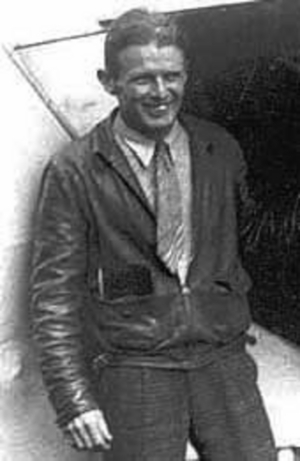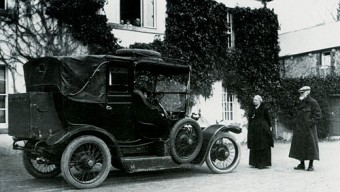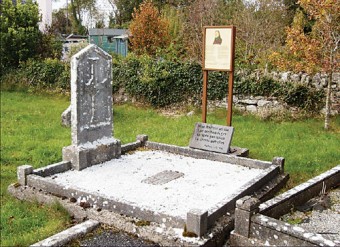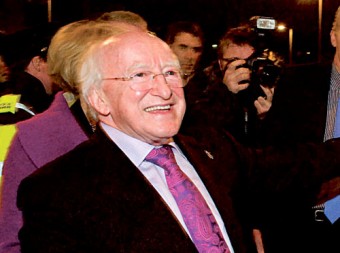Search Results for 'Douglas Hyde'
20 results found.
Thoor Ballylee - The perfect home for a poet
In August 1896 WB Yeats and his friend Arthur Symons went on a tour of the west of Ireland. The poet was 31 years of age. They stayed with Edward Martyn at Tulira Castle, Ardrahan, visited the Aran Islands, and Yeats made his first visit to Lady Gregory at Coole Park.
The Conradh na Gaeilge Oireachtas and Ard-Fheis held in the Town Hall 1913

Conradh na Gaeilge, also known as the Gaelic League, was founded by Douglas Hyde and Eoin McNeill in July 1893. Their aim was to keep the Irish language alive and preserve the Gaelic elements of Ireland’s culture. It was open to all creeds, was non-political, and accepted women on an equal basis. It used a broad approach, organising classes and competitions in Irish music, dancing, literature, and games. After a sluggish six years in existence, it suddenly morphed into a mass movement.
Wrong-way Corrigan and other wonders

Early morning July 17 1938, Douglas Corrigan, a young aviator, climbed into a small and rather battered nine-year old Curtiss Robin monoplane, at Brooklyn airfield New York. He was cleared to fly to California. It was a misty overcast morning. Instead of turning east, he headed out over the Atlantic. Twenty-eight hours later, surviving on two chocolate bars, two boxes of fig bars, and a few gallons of water, he landed in Baldonnel airport, Dublin, to everyone’s amazement. He was immediately christened ‘Wrong Way’ Corrigan, and the world press loved him. The New York Post printed its headline back to front to join in the fun. Especially as it emerged that Corrigan’s plane had many modifications made to it, including two large petrol tanks strapped in front of the cockpit, allowing him to only see out sideways. One of the tanks leaked on the way over. He had to slash a hole in the floor to allow the fuel out.
Books on my table
Despite Liam Mellows and his men answering the call to arms, and for five days to have caused mayhem in the Oranmore and Athenry areas, Galway was slow to realise that the Easter Rising 1916 was to be a permanent affair. The town was known as a ‘showneen town’, that is a town with a close allegiance to the British way of doing things. This was mainly because of the status of having a major army barracks on its doorstep. The army was an important purchaser of supplies from the town merchants; and many local people were soldiers, or had husbands or boyfriends who were in the army.
Lady Gregory Autumn Gathering returns this month

The Eighteenth Lady Gregory Autumn Gathering - a celebration of one of the leading figures of the Irish Literary Revival, 19th century Irish writing and culture, and south Galway - returns from September 28 to 30.
New initiative urges Westmeath people to cross the Shannon
A new initiative has been launched encouraging tourists to ‘revive, refresh, rewind’ across the Shannon in county Roscommon.
An Irish Colloquy at St Nicholas’
THE NATIONAL Chamber Choir of Ireland will present its concert An Irish Colloquy in St Nicholas’ Collegiate Church on Friday April 20 at 8pm, as part of its 2012 National Tour.
A blind poet’s love for Mary Hynes

South Galway still echoes with stories of Antoine O Raifteiri , and 18th century blind poet and fiddle player in the ancient bardic tradition. His best known poems are probably Cill Aodain, and Anach Cuan. He never wrote his poems down, but they were collected by Douglas Hyde, and Lady Gregory, from those whom he taught them to, after his death.
Michael D gets packin’ for the park

Michael D Higgins is this week preparing to leave Galway to move to Dublin where next week he will be installed as
Sir Roger Casement’s support for a small island in Galway Bay
Sir Roger Casement was a notable humanitarian and a British consul by profession but, ironically, an anti -Imperialist by nature. He over-stepped his diplomatic role to fiercely condemn Belgium for its brutalisation of the people of Congo*. His report, published in 1904, was however, well received by the British establishment, perhaps because it feared that little Belgium was getting too big for its boots, and too wealthy from its African ventures. Casement received a knighthood.

